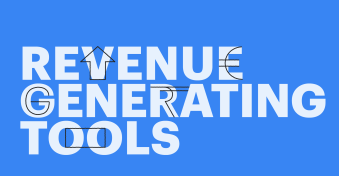Choosing the right e-signature platform is crucial for streamlining your business.
DocuSign is a key player in the digital signature space and is trusted by thousands of businesses around the world.
GetAccept is a sales enablement platform with e-signing, document creation tools, and a wider scope of focus.
Which of these cloud-based solutions is best for your business?
Let’s find out.
Key takeaways
- DocuSign offers a solid e-signing solution that feels narrow in scope and limited in functionality in today’s digital marketplace.
- GetAccept provides a suite of tools — including e-signing — meant to increase deal velocity and close time. The platform offers a broader toolkit but at a higher cost.
PandaDoc delivers an industry-agnostic solution that provides document creation and e-signing tools to any industry, team, or job role.
GetAccept
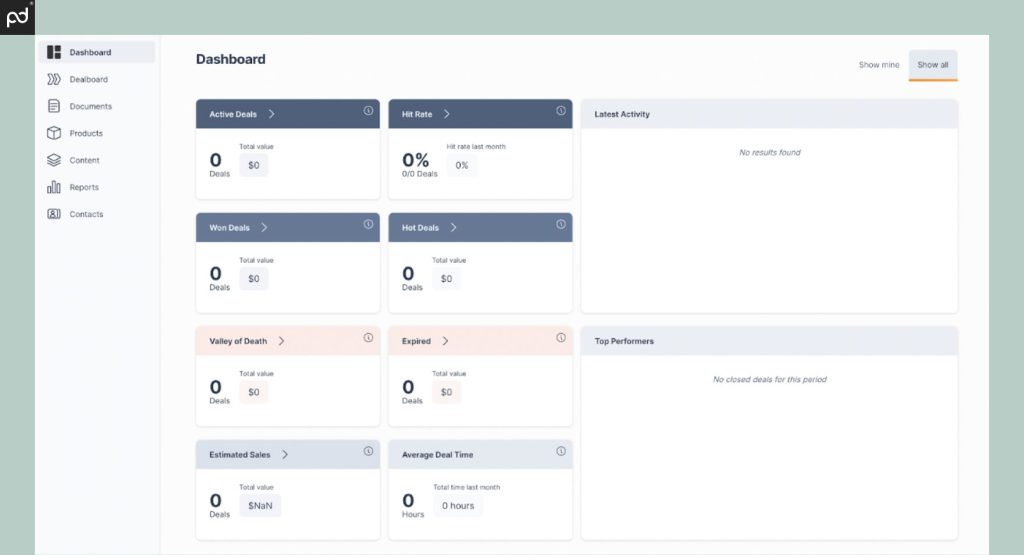
Pricing: eSign ($25); Deal Room ($39); Contract Room ($49); Full Suite ($79).
Pricing is month-to-month. Enterprise options also available.
Ease of use: 8.3/10
Free trial: Yes; 14 days.
Support: Knowledge base; live chat support.
GetAccept wants to help you close more deals, and they know secure digital signatures are a big part of that.
This platform isn’t just about capturing signatures.
GetAccept is all about sales enablement and making the deals process smoother, from sending out proposals that stun clients to getting signed documents back in record time.
The onboard editor is loaded with tools to help you create slick presentations, track how potential buyers interact with your stuff, and even chat with clients right inside the documents.
Think of it like a supercharged toolkit for salespeople.
GetAccept might be newer to the game than many of the old-school e-signature giants, but they’ve quickly made a name for themselves with their sales-focused approach, automation tools, improved document functionality, and general commitment to making your life easier.
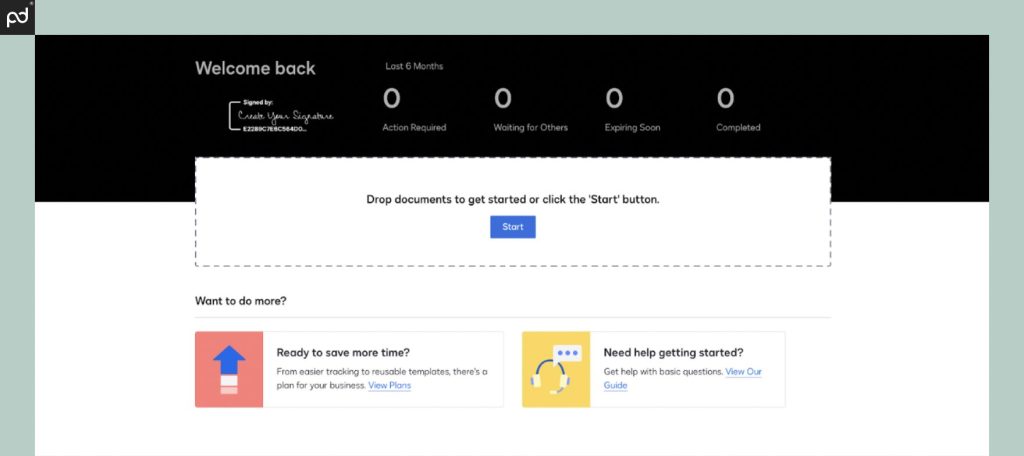
Pricing: Personal ($15); Standard ($45); Business Pro ($60). Enterprise pricing available.
All pricing based on month-to-month commitment.
Ease of use: 9.0/10
Free trial: Yes; 30 days.
Support: Knowledge base; support tickets; additional support plans sold as separate packages.
DocuSign is a powerhouse in the e-signature world, and they definitely know how to keep your documents safe and sound.
But that’s not all they’re about.
DocuSign really shines when it comes to making the signing process fast, easy, and hassle-free.
They back this up with over 400 ready-to-use integrations, 99.9% uptime, and pricing plans that work for everyone from small businesses to giant corporations.
DocuSign’s popularity comes from their laser focus on the e-signing aspects of your workflow and making the signoff process as smooth as possible.
For thousands of brands across multiple industries and countries, this makes them the last word in the electronic signature process.
GetAccept vs DocuSign at a glance
Ready to see how GetAccept and DocuSign compare to one another?
Here’s a closer look at the top-tier plans offered by both companies.
| Plan Details | DocuSign | GetAccept |
|---|---|---|
| Plan Name | Standard | Full Suite |
| Core product | ||
| E-signature capture | ✓ | ✓ |
| Real-time audit trail | ✓ | ✓ |
| Notifications | ✓ | ✓ |
| Language support | ✓ | ✓ |
| Mobile app (iPhone/Android) | ✓ | ✓ |
| Reporting tools | ✓ | ✓ |
| E-signing features | ||
| Signing order | ✓ | ✓ |
| Send to multiple recipients | ✓ | ✓ |
| Bulk send | ✓ | X |
| In-person signing | ✓ | X |
| Collaboration tools | ✓ | ✓ |
| Signer attachments | ✓ | ✓ |
| Payment gateway | ✓ | $ |
| Document prep | ||
| Drag & drop fields (PDF) | ✓ | ✓ |
| Create reusable templates | ✓ | ✓ |
| From-scratch document builder | X | Limited |
| Pre-built template library | X | ✓ |
| Form creation | ✓ | Limited |
| Custom branding | ✓ | ✓ |
| Integrations & API | ||
| Import & storage | ✓ | ✓ |
| CRM | X | $ |
| Productivity | ✓ | $ |
| API | $ | $ |
| Support | ||
| Email / ticketing support | ✓ | X |
| Chat support | X | ✓ |
| Knowledge base | ✓ | ✓ |
| Phone | X | X |
| Premium support options | $ | X |
While we’ve chosen to feature more advanced plans in the table above, it’s worth pointing out that both DocuSign and GetAccept also offer more cost-effective options (discussed below).
One key feature you should also consider are envelopes and transaction limits, which can limit the effectiveness and usage of your plan.
- DocuSign limits users to 100 envelopes per user/year and a maximum of 10 envelopes per user/month on most plans.
- GetAccept has no transaction limit on any plan, meaning that users can send as many documents as needed without penalty, but the eSign plan can only have 10 sent documents in circulation at a time.
Although subtle, this small distinction can completely change how sales teams utilize each platform.
Reps using GetAccept can leverage the onboard tools to send documents without restriction, allowing them to leverage all aspects of the platform (document signing, contract management, etc.) for maximum value.
Requirements, plans & pricing
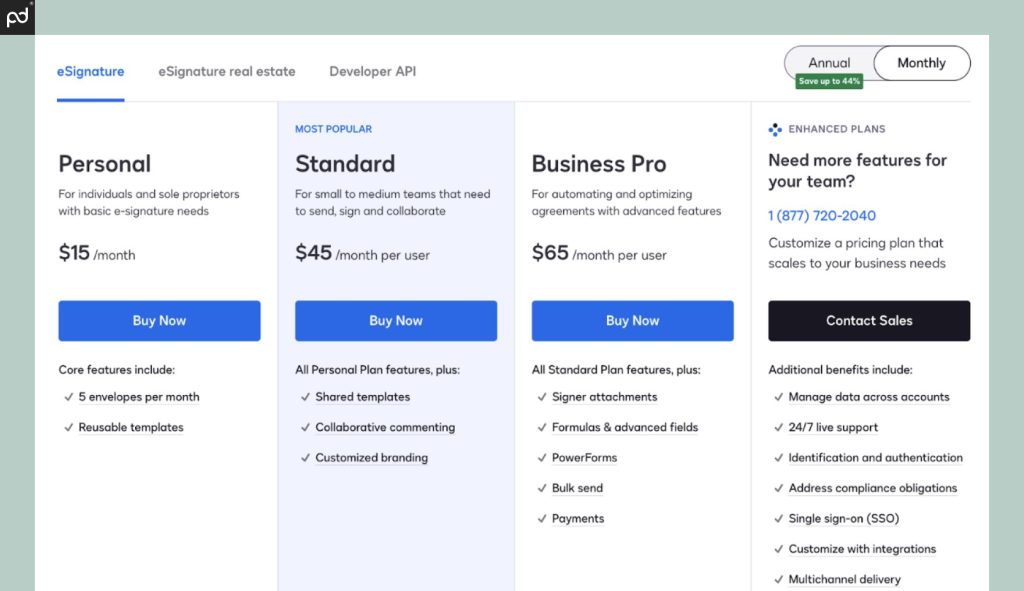
When comparing DocuSign and GetAccept, one of the best places to start is with pricing options.
Both companies offer a variety of plan types, each tailored to business size and user need.
Overall, DocuSign offers the most straightforward plan options and the most direct feature set.
An e-signature software to its core, each plan is here to facilitate document signing in a user-friendly way and little else.
Aside from its real estate plans (similar cost, similar features), DocuSign offers three pricing tiers before climbing to a customizable, enterprise-level plan.
- Personal ($10/user per month). Focuses on individual needs with unlimited signature collection, basic fields, and mobile compatibility.
- Standard ($25/user per month). Introduces more customization, payment collection, and reminders, ideal for small teams.
- Business Pro ($40/user per month). Unlocks advanced fields, bulk send options, and additional branding features.
Notably, the Personal plan only provides five envelopes per month, while the Standard plan and above is limited by the 10 envelope/month and 100 envelope/year transaction cap.
However, according to DocuSign, the transaction limit is a “soft cap” meaning that they won’t disable your plan.
Instead, you’ll be put in touch with a sales team to work out a cost for the additional transactions you need to send.
Aside from the technicalities around transaction limits, DocuSign’s plans are relatively straightforward.
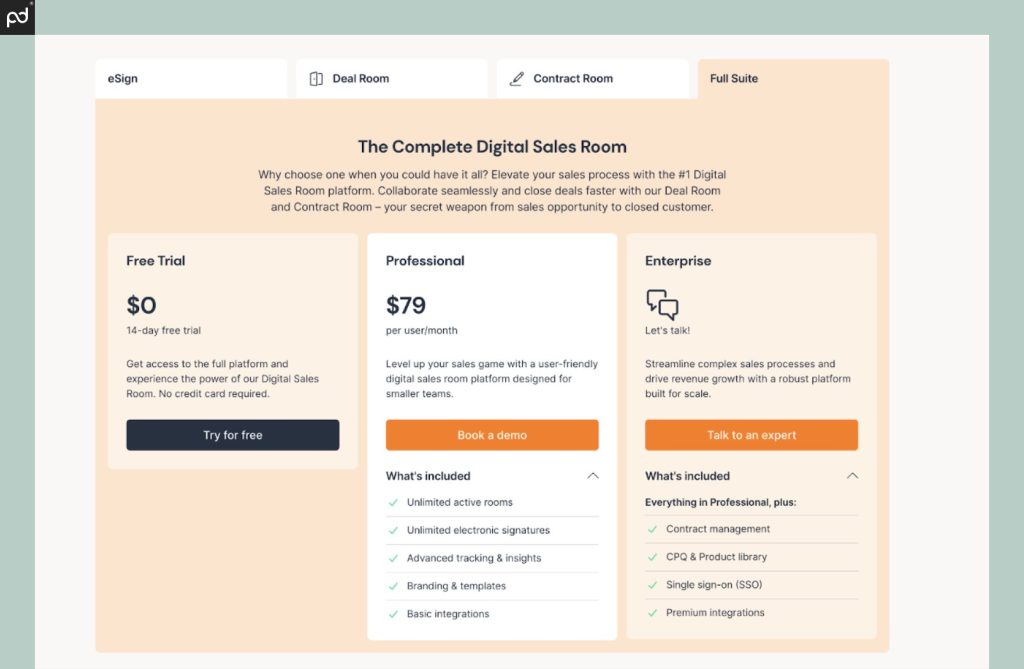
On the other hand, GetAccept’s pricing structure is a little more confusing — in part because GetAccept is as much a sales enablement tool as an e-signature software.
With GetAccept, users pick which plan they want based on the features that it offers and can then decide whether they want the Professional or Enterprise version of that plan.
The plans are as follows:
- eSign (formerly Essentials) ($25 per user/month). Provides straightforward e-signing options, an onboard editor, and limited engagement functionality.
- Deal Room ($39 per user/month). Focuses on deal management, buyer/seller collaboration, and the sales process.
- Contract Room ($49 per user/month). Includes e-signature and negotiation tools, fast content generation, and an expedited CPQ process. (Also includes all features in eSign plan).
- Full Suite ($79 per user/month). The total package. Combines all Deal Room and Contract Room features.
Still with us? Now, we’re going to add a final layer of complexity to GetAccept’s pricing.
For all plans except eSign, you can choose to upgrade from the Professional Version of the plan to the Enterprise version, which typically features tools for single sign-on (SSO), premium integration options, and a couple of important features like contract management for a dedicated product library.
If you’re keeping count, that means you have a total of seven pricing options to choose from!
While it’s a little confusing, this approach provides more plan variety and can help you better select the plan that makes sense for your team.
As you might expect, GetAccept would prefer that you take the Full Suite option, since it provides all the benefits of the other plans.
However, it’s worth taking the time to read the fine print. You may find that the features you need are actually included in a lower-tier plan.
For example, all plans feature GetAccept’s onboard content library and in-app editor — even the lowest-tier eSign plan.
If you’re just looking for an e-signature solution and don’t want to take advantage of sales enablement features on the GetAccept platform, that might be a good option.
However, be advised that GetAccept limits sendouts on the eSign plan to a maximum of 10 at a time.
Our suggestion
Before deciding which platform to use, take a step back and consider what you’re really looking for.
Overall, GetAccept offers more than DocuSign but at a higher cost.
While the month-to-month pricing is competitive, DocuSign’s annual commitments drop the price significantly.
On the other hand, DocuSign’s transaction limits can impact usage.
GetAccept offers a way around that, which will be useful for high-volume senders.
If you don’t want to deal with the confusion around picking plans and negotiating transaction limits, PandaDoc is a great alternative.
- DocuSign offers a straightforward, user-friendly e-signing solution with notable transaction limits and limited document editing capabilities.
- GetAccept provides no-limit sending (except on the eSign plan), but its pricing structure is confusing, and it may offer tools you don’t need.
- PandaDoc offers straightforward pricing, true no-limit sending for all plans, onboard document editing tools, and much more.
Document preparation & e-signing
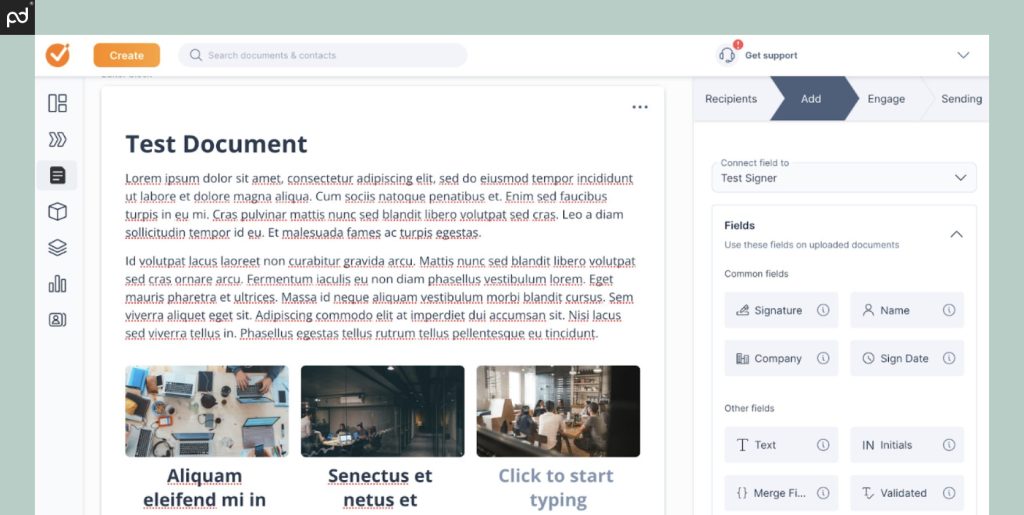
Both DocuSign and GetAccept each position themselves differently as part of your document process.
That makes a huge difference in how they interact with your contracts and sales docs and where you fold these platforms into your workflow.
GetAccept approaches documents with a sales-centric mindset.
You can create polished proposals and contracts directly within their platform, adding videos, custom branding, and other engaging elements.
(Note: PandaDoc also takes this approach. Our document builder, content library, and other template tools mean that users can start and end their entire document process in one app!)
Similar to DocuSign, you can use drag-and-drop tools to place signature fields, text boxes, and other essential elements once you’ve finished creating your document.
Afterward, you can assign signers, set signing orders, and send the document for signature.
Throughout the entire process, you can track document status, collaborate and chat with clients directly within the document, and utilize sales analytics to optimize your deal flow.
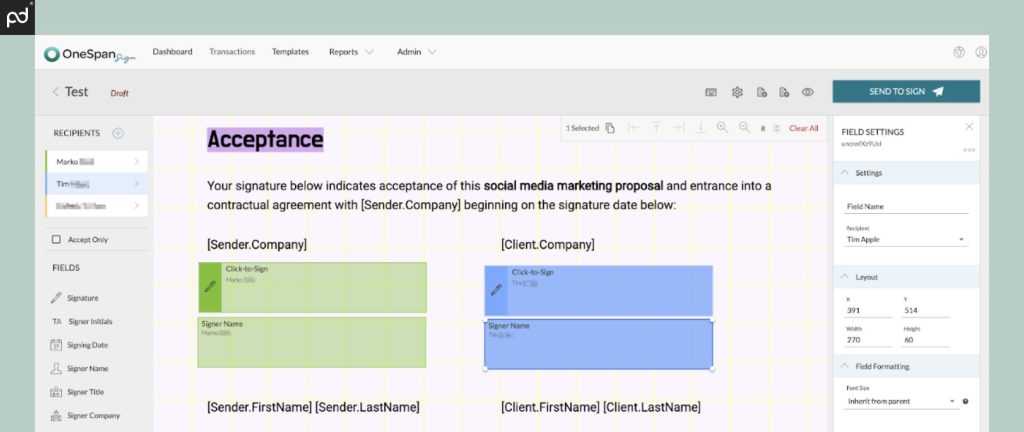
Compared to GetAccept, DocuSign focuses on a much smaller part of the e-signing process.
With DocuSign, you’ll need to create your documents using an external word processor (like Word or Google Docs) and then upload them to the DocuSign platform.
That’s a major deviation from GetAccept (or PandaDoc), where you can design the document inside an onboard editor.
Once you’ve uploaded your document, you can use DocuSigns drag-and-drop tools to place the necessary signature, date, and text fields.
This aspect of document creation is standard across most e-signing tools and will feel familiar if you’ve ever prepared documents before.
After you’ve finished with document prep, you can adjust the signing order, add any additional messaging, and send your documents for completion.
Once sent, DocuSign tags the sent envelope as “in flight,” counts it against your transaction limit (even if it is never signed).
Like GetAccept, DocuSign will notify you when documents are received, reviewed, and signed.
Though you won’t be able to live chat with clients while the document is being designed and prepared, DocuSign does offer commenting tools for reviewers to provide feedback after the document has been sent.
Unfortunately, because DocuSign lacks editing capabilities, any major revisions to a proposal or contract will need to be adjusted using your word processing software.
That’s a drawback when compared to GetAccept, where documents can be adjusted in the editor and returned to signers without ever leaving the platform.
Our suggestion
The right choice here will come down to your existing document workflow, how much you like it, and whether you’re willing to change it.
If your existing process involves Word or Google Docs, and you only need a signing platform, many of GetAccept’s features may not make sense for you.
However, if you’re a sales team looking for a sales enablement tool that can handle the majority of your document process, the GetAccept/PandaDoc approach is a much better option because the platform consolidates everything you need into a single software tool.
That, combined with the right CRM integrations, makes document processes remarkably efficient.
- DocuSign is an ideal choice if you’re looking for a no-frills, straightforward signing solution and you’re happy with all other aspects of your document workflow.
- GetAccept excels for sales teams who want the tools to streamline everything from proposal creation to closing deals, all built around the e-signature workflow.
- PandaDoc is the winner for teams looking for something in between. While PandaDoc can support sales teams, our open-ended solution is also a great fit for legal, HR, and other teams.
Integrations
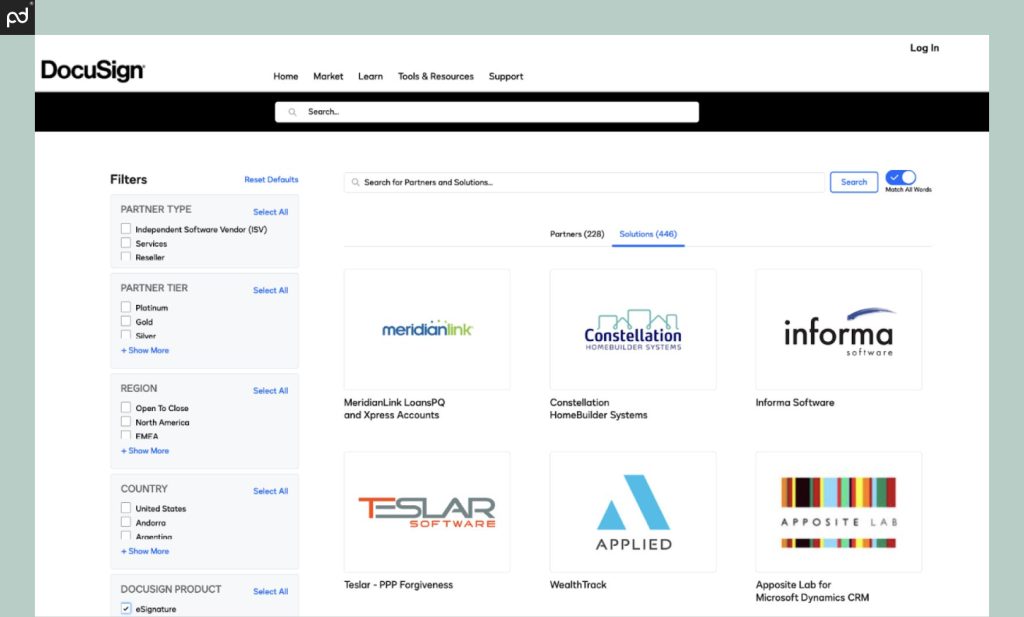
When comparing integration options, both DocuSign and GetAccept have a variety of options to consider.
DocuSign boasts one of the most extensive integration libraries in the e-signature market, and the platform’s deep integration capabilities make it a top choice for organizations that rely heavily on a complex tech stack or work with niche, industry-specific software.
The company offers seamless connections to hundreds of popular business tools across categories, cloud storage (Google Drive, Dropbox), productivity suites (G-Suite, Microsoft Office), payment processors, and many more.
Some of the apps — like the storage and partner integrations — are available across all plans, while others require some upfront costs.
Payment integrations (included on all PandaDoc plans!) are gated behind DocuSign’s Business Pro plan.
Unfortunately, CRM integrations like Salesforce and Microsoft Dynamics are fully locked behind the enterprise plans and are only available as part of a custom configuration.
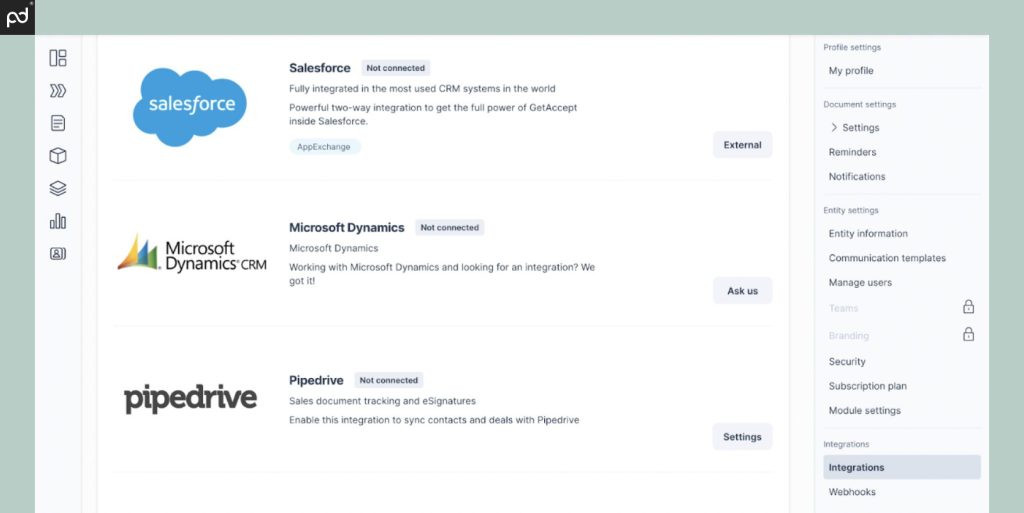
Meanwhile, GetAccept offers a solid range of integrations that prioritize streamlining the sales journey, but understanding how they work is a bit tricky.
You’ll find connectors for most popular CRMs (Salesforce, HubSpot, Pipedrive, and others), as well as productivity tools like Slack and other platforms that can directly enhance sales workflows.
At the Professional tier, most integrations aren’t automatically included and availability varies depending on your needs.
For instance, the HubSpot integration works with both Deal Room and Contract Room plans, but payment gateways are exclusive to the Contract Room plan.
If you want access to the complete range of integrations, the Full Suite plan is the way to go, as it combines features from both Deal Room and Contract Room.
However, at the Professional tier, only a few integrations come standard.
Most will need to be purchased separately as add-ons.
Upgrading to the Enterprise plan will give you default access to most integrations, but there are still a few options (API, automation tools, etc.) that will incur an additional fee.
Our suggestion
Integrations are powerful tools, and both GetAccept and DocuSign make them available.
Unfortunately, enabling the ideal integrations on either platform feels overly complicated.
At PandaDoc, we offer payment gateways, productivity, and storage integrations for all plans.
Most CRM integrations are available by default, with premium CRM tools available as add-ons for our Business and Enterprise plans.
By comparison, the approach by both GetAccept and DocuSign feels overly complex and complicated.
- DocuSign is the undisputed king when it comes to integration variety. The company has native connectors for hundreds of obscure software solutions in its partner library.
- GetAccept offers integrations that are all about sales enablement. Unfortunately, using them as a non-Enterprise user incurs additional costs that will drive up the price of your monthly subscription.
- PandaDoc offers most integrations as part of the normal suite of plans but reserves premium integrations for Business and Enterprise plans as an optional add-on.
Customer support
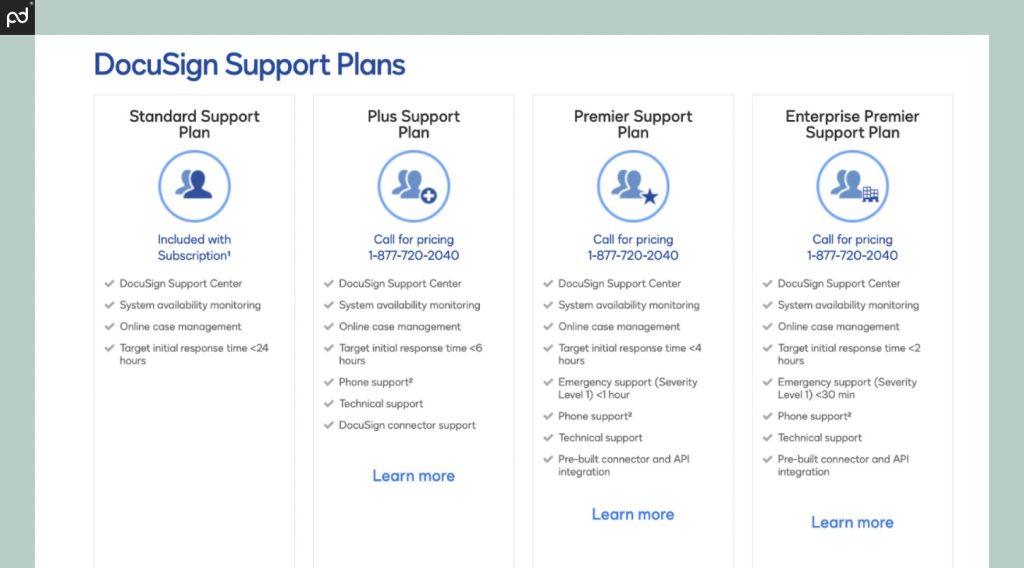
For e-signing platforms, access to support can be critical since obstructions and system failures can disrupt contracts and deal flows.
It’s one reason that we offer 24/7 chat support and premium support options at PandaDoc.
However, DocuSign and GetAccept both approach support packages very differently.
With DocuSign, all plans default to the Standard Support Plan automatically.
This baseline plan features a self-help knowledge base and a targeted 24-hour response time for most key issues.
It’s a ticketing system, so you’ll submit your request and wait for a response from a technician.
With the system that DocuSign has set up, users on the default plan should expect to wait a while for support.
The issue might be a quick fix, but it will take some time for the support team to reply and help you resolve matters.
It’s possible to get a faster response from DocuSign by upgrading your support plan to a higher tier.
At the highest level (Enterprise Premier Support), response times drop to under two hours and below 30 minutes for critical issues.
That’s a huge difference for teams where time is money.
But, in order to leverage faster response times, you’ll need to purchase that extra support.
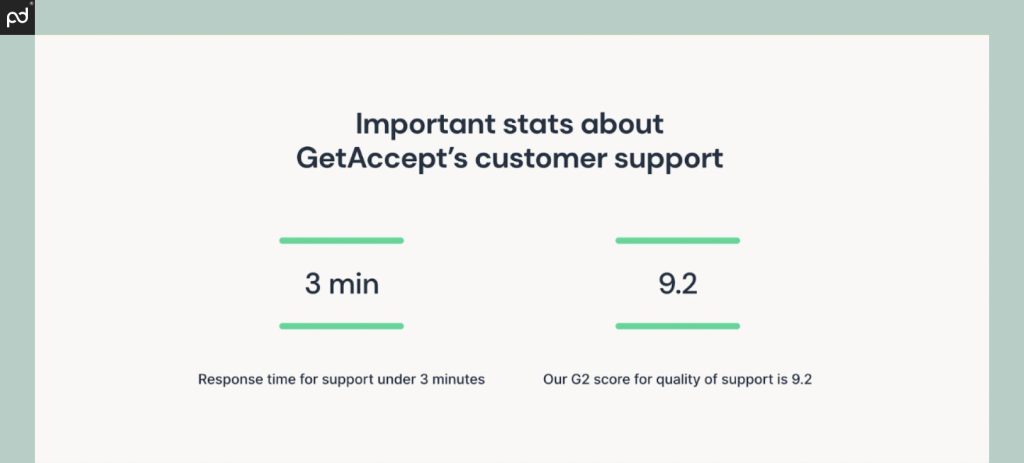
By contrast, GetAccept offers personalized support options to users at every level via a help center and live chat.
While their chat solution isn’t 24/7 like what we have at PandaDoc, it’s close.
Listed hours are between 06:00 – 00:00 UTC, which will cover most working business hours in most time zones.
With GetAccept, you’ll need to chat with their support team to get help within a few minutes.
Often, the rep will be able to answer questions and resolve minor issues.
Bugs or systems issues might cause a delay that requires an escalation, but the process is much quicker because help is just a chat away.
For premium support, GetAccept also offers access to a customer success manager.
This add-on feature will provide support to help your team onboard quickly and help you figure out how best to utilize the GetAccept platform.
However, this isn’t a requirement for chat support.
Overall, the support experience with GetAccept feels much faster and accessible.
From customer reports, you can expect (much) shorter wait times, a more personalized experience, and faster hands-on solutions to resolve your issues.
Our suggestion
At PandaDoc, we’re serious about supporting customers.
We offer 24/7/365 chat support because we feel that it’s the best and most responsive way to resolve unexpected issues that our users face.
We appreciate when other companies offer similar solutions rather than relying on ticket submissions and long wait queues.
It’s a change that results in a better experience for everyone.
- DocuSign defaults users to the Standard support package, which can result in long wait times. However, teams willing to pay for enterprise-level support will see much faster responses.
- GetAccept offers live chat support for all plans except eSign, so issues can be resolved or escalated immediately and with minimal delays.
- PandaDoc Support is available for all plans via live chat, including any trials, free plans, or entry-level solutions.
Alternatives to GetAccept and DocuSign
While DocuSign and GetAccept are popular choices for many users, they won’t be the ideal fit for every business.
Explore these alternatives to find the e-signature platform that aligns perfectly with your industry, workflow, and budget.
- PandaDoc
- Adobe Acrobat Sign (formerly Adobe Sign)
- Dropbox Sign (formerly HelloSign)
- SignNow
- Signeasy
We’re probably a little biased, but PandaDoc stands out as a remarkably balanced and user-friendly solution for many businesses.
Our open-ended approach to document creation and management means that we can support sales, HR operations, and other departments by creating streamlined workflows that everyone can use.
If you’re looking for an e-signature solution that is easy to adopt and that can grow with your business over time, give PandaDoc a try.
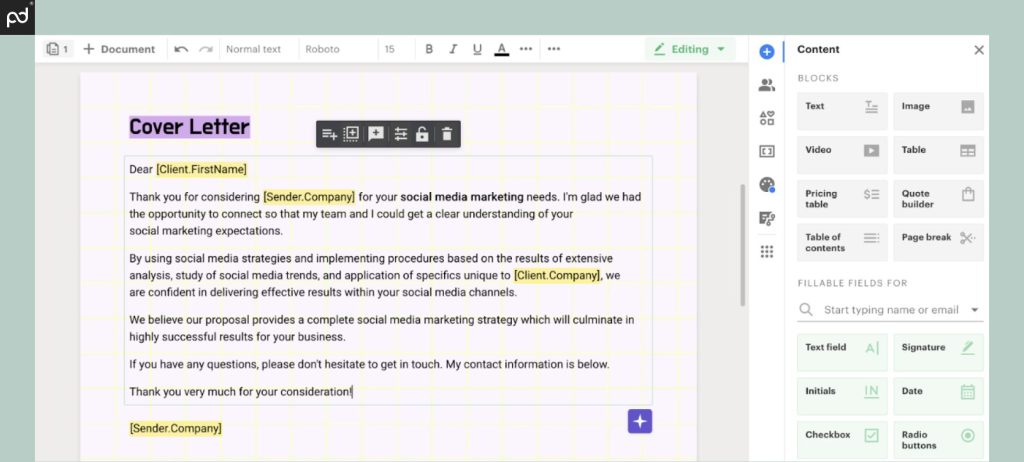
Build better documents with PandaDoc
Both GetAccept and DocuSign are powerful e-signature platforms that can streamline business processes.
However, each comes with its unique set of strengths and potential complexities and setbacks.
DocuSign is document agnostic but very narrow in scope.
You can use it to sign any document, but the platform won’t assist with document creation or optimize your existing workflows.
GetAccept offers some of these tools, but it’s centered around sales enablement. Plus, the platform’s pricing structure can be confusing to configure.
If you’re looking for a straightforward solution that can level up your document workflow and e-signing process, look no further than PandaDoc.
Our intuitive document editor, seamless access to essential integrations, and no-nonsense pricing structure makes it easy to do more in less time.
Take the guesswork out of choosing your next e-signature solution!
Sign up for a 14-day trial of PandaDoc or schedule a demo today.
Discover how PandaDoc can transform the way you create, send, and manage your most critical documents.
Disclaimer
Parties other than PandaDoc may provide products, services, recommendations, or views on PandaDoc’s site (“Third Party Materials”). PandaDoc is not responsible for examining or evaluating such Third Party Materials and does not provide any warranties relating to the Third Party Materials. Links to such Third Party Materials are for your convenience and do not constitute an endorsement of such Third Party Materials.
Originally published April 6, 2021, updated May 9, 2024

